Coral reefs
Topography of coral reefs
Coral reefs are landforms created by corals and other organisms over a long period of time. The interactions between mountains, rivers, and oceans drive the health of coral reefs. Plain fields spread out from the mountains, and sandy beaches are intercepted with rocks along the coast. When entering the sea from sandy beaches, you see seagrass grow in shallow areas, while coral reefs spread out in the deeper areas that surround islands.
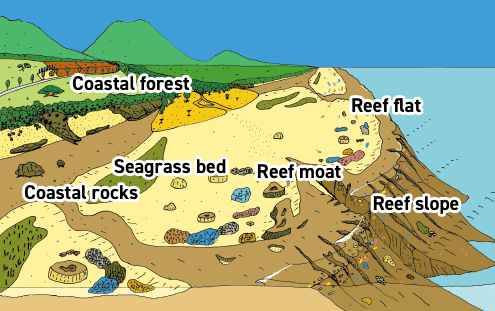
- Coastal forest:
Natural vegetation can withstand typhoons. - Coastal rocks:
Coastal rocks contain several fossils, including those of corals. - Seagrass bed:
A seagrass bed consists of colonies of algae and seaweed, serving as a breeding ground for young fish. - Reef moat:
A reef moat is a shallow, quiet region of the sea surrounded by reef flats, wherein a variety of corals form colonies. - Reef flat:
A reef flat is a region where coral reefs grow and rise up. Reef flats dry out at low tides and often experience high waves. - Reef slope:
Reef slopes have a complex topography, with sharp depths. They are inhabited by several types of corals.
Shape of coral reefs
Fringing reef

A fringing reef is the most common type of reef and generally surrounds the shore. The majority of coral reefs in Japan are of this type.
Barrier reef

Barrier reefs are similar to fringing reefs, however, the outer edge of a barrier reef is always separated from the land/shore, and a deep sea lagoon may be formed inside the reef.
Atoll reef

Atoll reefs are circular reefs that are exposed to the sea surface, with no land in the center. They are commonly found in the South Pacific Ocean.
Patch reef

Patch reefs are reefs that are isolated and separate from the land, but in close proximity to shores. Several small patch reefs are found around Japan.
What are corals?
Corals are animals
Corals look like plants, but they belong to the same family as sea anemones.
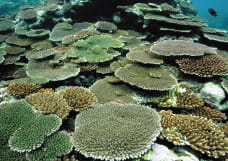
Corals are made up of many small individual organisms called polyps.
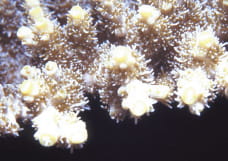
These polyps look like sea anemones.

Polyps have a simple structure. A mouth, which is connected to the stomach, is located at the center of tentacles that spread out radially. The difference between sea anemones and coral polyps is that the latter have a hard skeleton.
Polyps are inhabited by phytoplankton called zooxanthellae. Zooxanthellae use sunlight to perform photosynthesis, thereby providing nutrients to corals. Corals themselves catch and eat food using their tentacles. Although corals are animals, they also have plant-like characteristics, owing to the plants living inside their bodies.
Family of corals
Corals belong to the family of Cnidaria, which includes sea anemones and jellyfish. Among them, corals that have a hard calcareous skeleton and build reefs are called "reef-building corals."
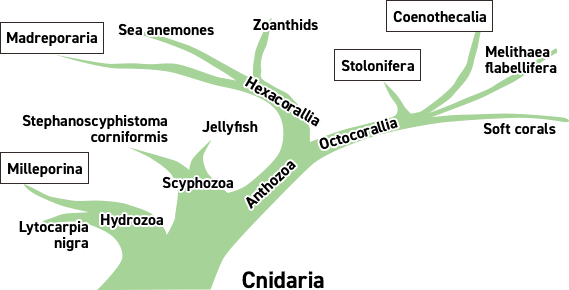
The diagram above is a phylogenetic tree portraying the classification of organisms. Reef-building corals consist of four groups: Madreporaria, Coenothecalia, Stolonifera, and Milleporina. Among these, "Madreporaria" contains the largest number of species, with over 300 species confirmed in Japan alone.
Life of corals
Corals reproduce by sexual reproduction, by spawning eggs, and asexual reproduction, by cloning through division.
Sexual reproduction
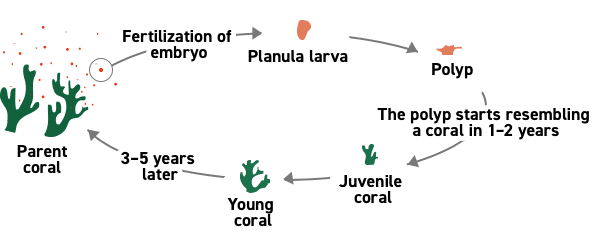
The fertilized embryo, called planula larvae, spend some time floating on the water surface. They grow into polyps and anchor themselves to rocks and other surfaces. Then, they grow through multiplication, and in 3-5 years, they reach the stage at which they can spawn eggs.
Asexual reproduction

Corals grow from a few to over 10 cm in a year; their growth rate varies depending on the species and habitation environment.
Spawning of corals
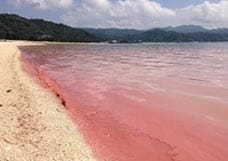
In Okinawa, staghorn corals spawns eggs at night at high tide during May–June. The day after spawning, the sea surface turns red owing to the large volume of eggs spawned by the species.
Roles of coral reefs
As Natural breakwater structures
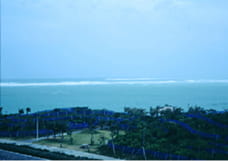
- Coral reefs serve as living breakwaters; they reduce the force of high waves during typhoons, cyclones, and sea storms.
- Coral reef skeletons and foraminiferal shells break down into sand, thereby protecting the coast by creating rich sandy beaches.
As Resources
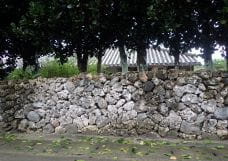
- Coral reefs provide various resources, e.g., building materials, household goods, and fertilizers.
- In the future, important discoveries may root from coral reefs, e.g., medicines and food supplements.
Supporting education and research
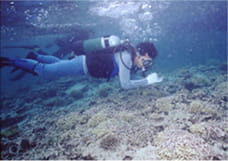
- Coral reefs serve as a natural school. As part of environmental education, coral reefs are playing an increasingly important role for nature observation sessions and beautification activities.
- Notably, the knowledge about the organisms that inhabiting coral reefs is limited. Thus, coral reefs serve as a live laboratory that can provide valuable insights into the mechanisms of marine environments and organisms.
Let us protect coral reefs
The coral reefs in the Sekisei lagoon are currently disappearing, and their functions are declining. Let's take a look at some of the causes.
Crown-of-thorns starfish
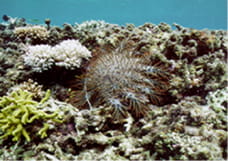
- The crown-of-thorns starfish is a large starfish that can grow up to 50 cm in diameter. It has sharp poisonous thorns on the surface of its body.
- In the 1980s, an outbreak of crown-of-thorns starfish occurred in the Sekisei lagoon, devouring and destroying the coral reefs. Similar outbreaks occurred in the late 2000s and early 2010s.
- There are several organisms, other than crown-of-thorns starfish, that eat corals. However, not all such organisms are threaten corals; in fact, the majority of them are the members of coral-reef organisms.
Coral bleaching

- Coral bleaching is a phenomenon that occurs when the seawater temperature is too high or low, or when the ultraviolet radiation is too strong or weak.
- In the Sekisei lagoon, coral bleaching occurred in 1998, 2007, and 2016.
- The photo on the left portrays an example of coral bleaching caused by the blocking of sunlight.
Notably, corals are delicate organisms and rapidly react to environmental changes. In coral bleaching, the deterioration of the environment causes the disappearance of zooxanthellae that live inside the body of corals. When this occurs, the corals lose their color and turn white, this process is referred to as "bleaching." If the bleaching phenomenon continues for a period of time, the corals die.
Red soil pollution
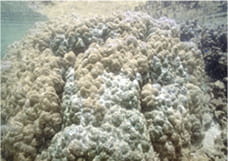
- During heavy rains, bright red, murky water flows into the ocean from bare land regions, generally from construction sites and farmland. Consequently, fine mud is deposited onto the ocean floor, reducing the mobility of corals and resulting in suffocation (which may lead to their death).
- Red soil pollution affects several industries, including tourism, agriculture, and fishing.
Overexploitation
- The disruption of mountains, rivers, and oceans by overexploitation has a negative impact on coral reefs.
- Healthy relationships among forests, rivers, mangrove forests, and tidal flats are important for the preservation and health of coral reefs.
